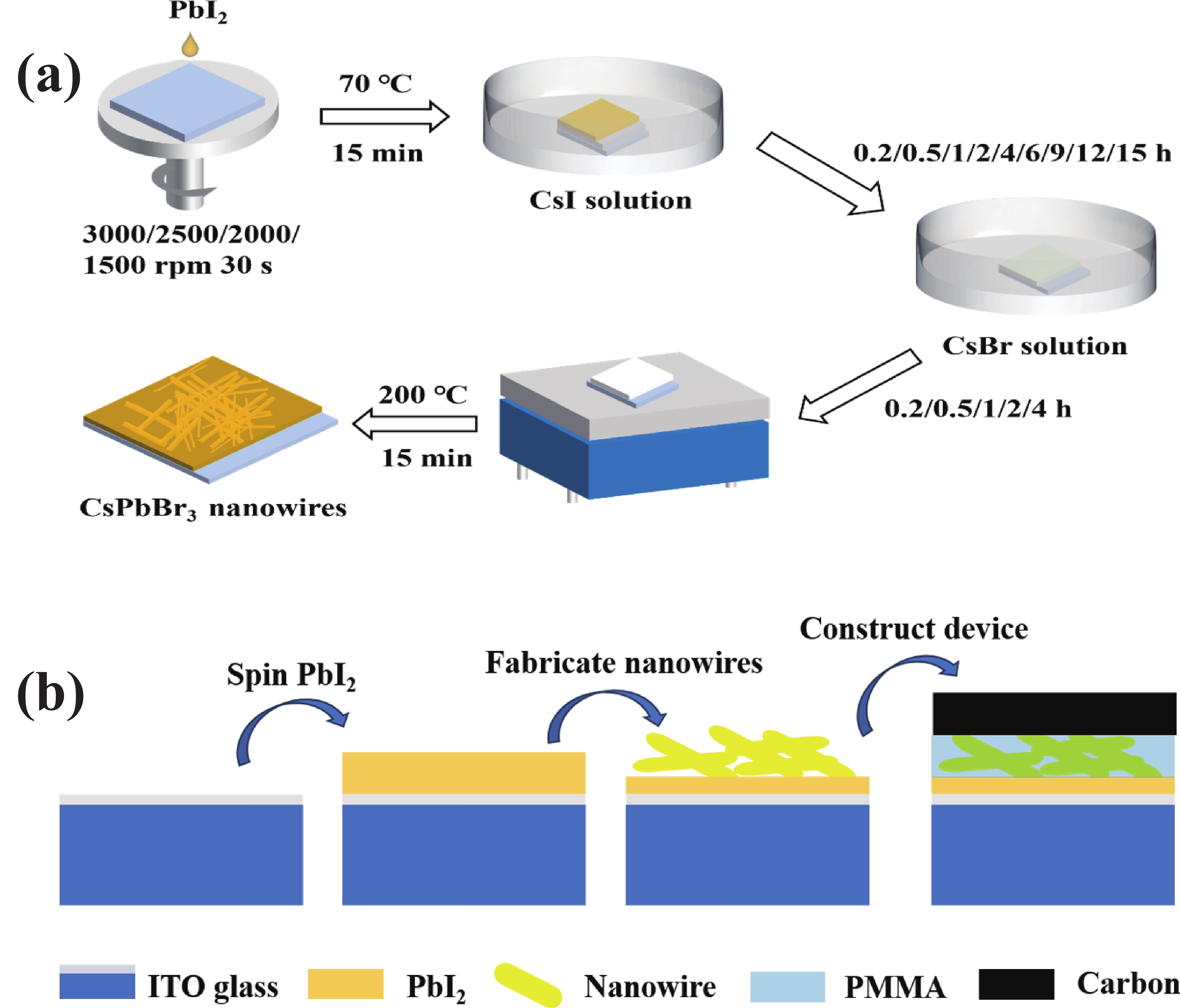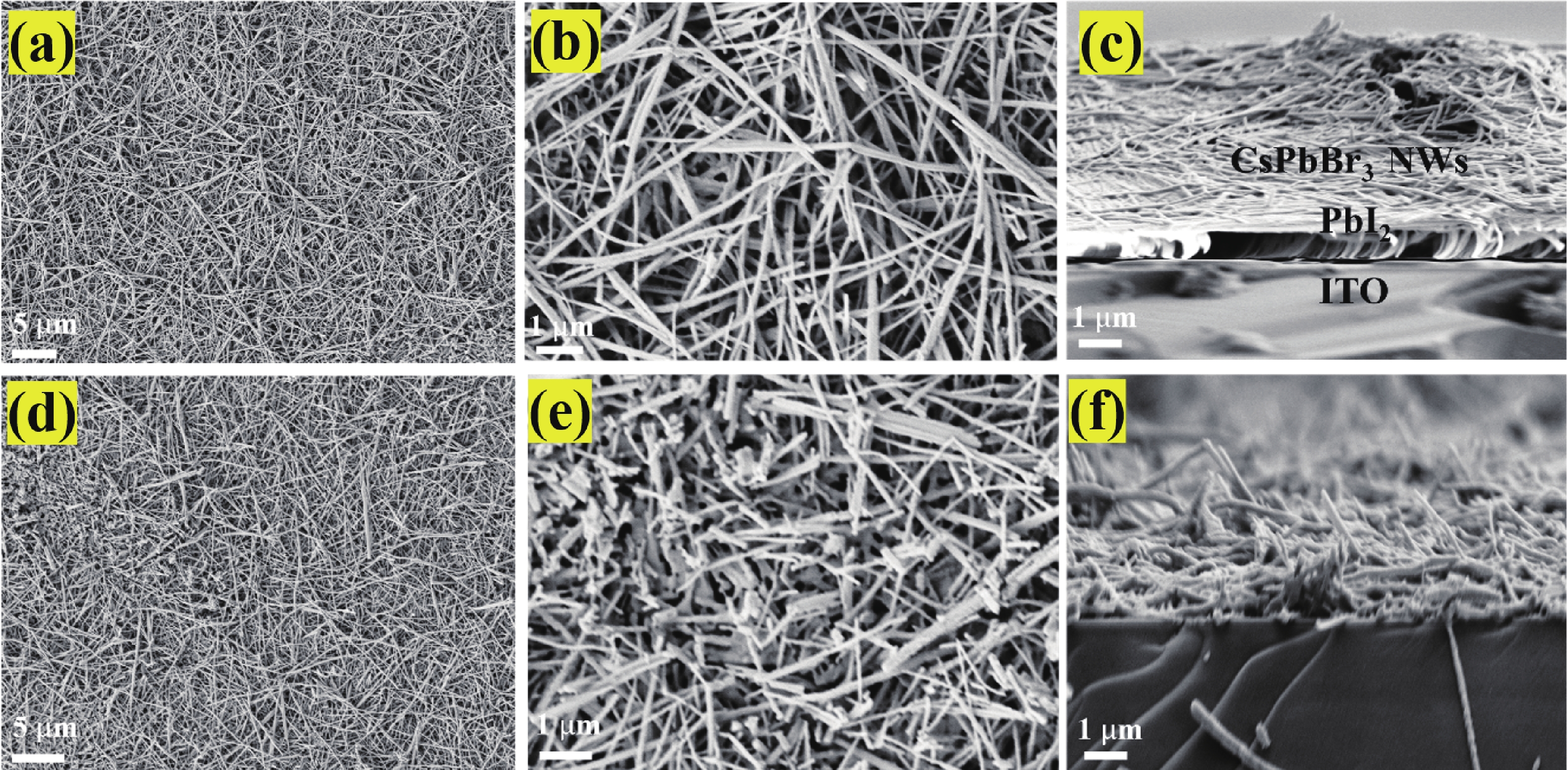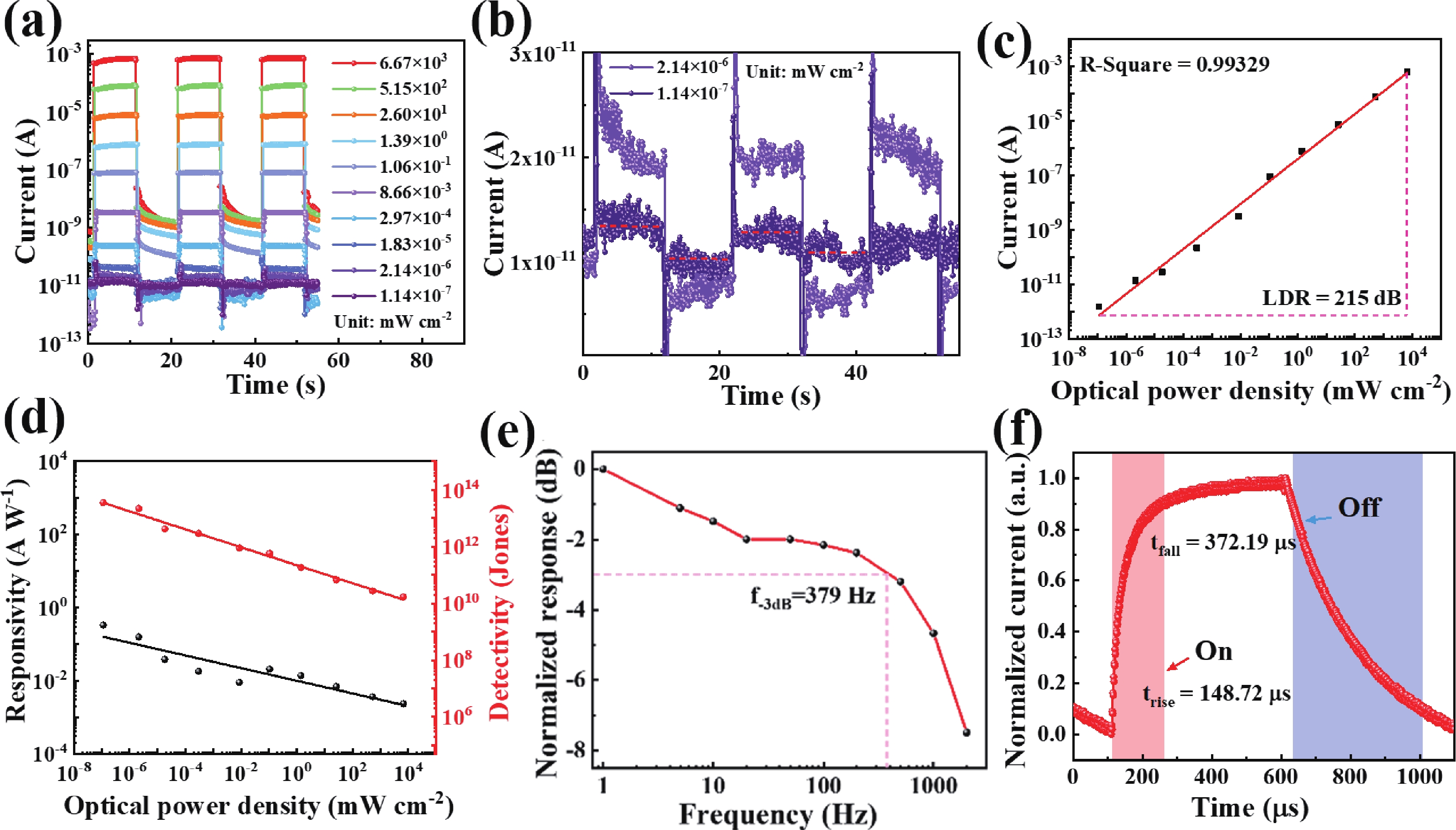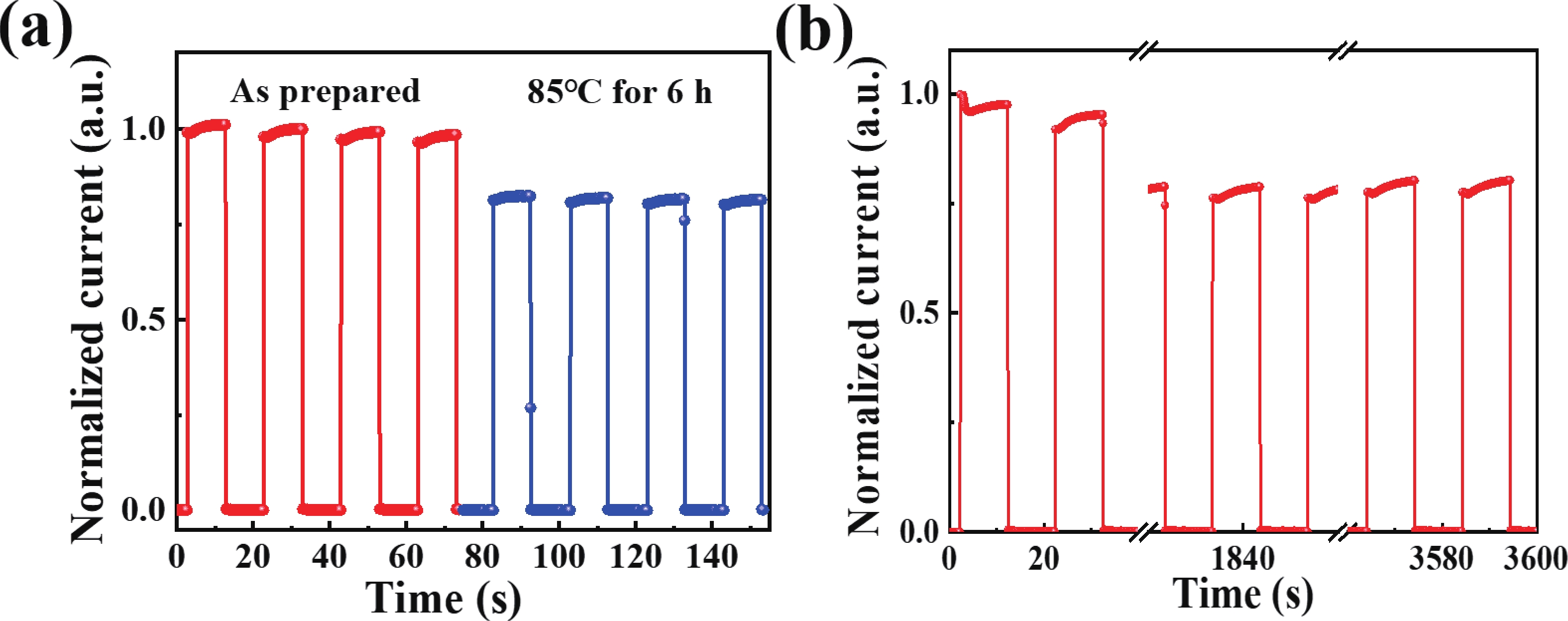| Citation: |
Yapeng Tang, Bo’ao Xiao, Dingjun Wu, Hai Zhou. Multi-functional PbI2 enables self-driven perovskite nanowire photodetector with ultra-weak light detection ability[J]. Journal of Semiconductors, 2025, 46(5): 052801. doi: 10.1088/1674-4926/24110016
****
Y P Tang, B A Xiao, D J Wu, and H Zhou, Multi-functional PbI2 enables self-driven perovskite nanowire photodetector with ultra-weak light detection ability[J]. J. Semicond., 2025, 46(5), 052801 doi: 10.1088/1674-4926/24110016
|
Multi-functional PbI2 enables self-driven perovskite nanowire photodetector with ultra-weak light detection ability
DOI: 10.1088/1674-4926/24110016
CSTR: 32376.14.1674-4926.24110016
More Information-
Abstract
High-performance perovskite photodetectors with self-driven characteristic usually need electron/hole transport layers to extract carriers. However, these devices with transport layer structure are prone to result in a poor perovskite/transport layer interface, which restricts the performance and stability of the device. To solve this problem, this work reports a novel device structure in which perovskite nanowires are in-situ prepared on PbI2, which serves as both a reaction raw material and efficient carrier extraction layer. By optimizing the thickness of PbI2, nanowire growth time, and ion exchange time, a self-driven photodetector with an ITO/PbI2/CsPbBr3/carbon structure is constructed. The optimized device achieves excellent performance with the responsivity of 0.33 A/W, the detectivity of as high as 3.52 × 1013 Jones. Furthermore, the device can detect the light with its optical power lowered to 0.1 nW/cm2. This research provides a new method for preparing perovskite nano/micro devices with simple structure but excellent performance.-
Keywords:
- nanowire,
- PbI2,
- perovskite,
- photodetector
-
References
[1] Zhu H W, Teale S, Lintangpradipto M N, et al. Long-term operating stability in perovskite photovoltaics. Nat Rev Mater, 2023, 8, 569 doi: 10.1038/s41578-023-00582-w[2] Zhang L W, Zhou H, Chen Y B, et al. Spontaneous crystallization of strongly confined CsSnxPb1-xI3 perovskite colloidal quantum dots at room temperature. Nat Commun, 2024, 15, 1609 doi: 10.1038/s41467-024-45945-1[3] Lin R X, Wang Y R, Lu Q W, et al. All-perovskite tandem solar cells with 3D/3D bilayer perovskite heterojunction. Nature, 2023, 620, 994 doi: 10.1038/s41586-023-06278-z[4] Dong K L, Zhou H, Shao W L, et al. Perovskite-like silver halide single-crystal microbelt enables ultrasensitive flexible X-ray detectors. ACS Nano, 2023, 17, 1495 doi: 10.1021/acsnano.2c10318[5] Aydin E, Allen T G, De Bastiani M, et al. Pathways toward commercial perovskite/silicon tandem photovoltaics. Science, 2024, 383, eadh3849 doi: 10.1126/science.adh3849[6] Zhou H, Song Z N, Grice C R, et al. Self-powered CsPbBr3 nanowire photodetector with a vertical structure. Nano Energy, 2018, 53, 880 doi: 10.1016/j.nanoen.2018.09.040[7] Li G Y, Li S H, Ahmed J, et al. Flexible perovskite photodetector with room-temperature self-healing capability without external trigger. InfoMat, 2024, 6, e1259 doi: 10.1002/inf2.12594[8] Gao Z, Zhou H, Dong K L, et al. Defect passivation on lead-free CsSnI3 perovskite nanowires enables high-performance photodetectors with ultra-high stability. Nano Micro Lett, 2022, 14, 215 doi: 10.1007/s40820-022-00964-9[9] Wang F, Zou X M, Xu M J, et al. Recent progress on electrical and optical manipulations of perovskite photodetectors. Adv Sci, 2021, 8, 2100569 doi: 10.1002/advs.202100569[10] Zhou H, Wang R, Zhang X H, et al. High-performance, flexible perovskite photodetector based on CsPbBr3 nanonet. IEEE Trans Electron Devices, 2023, 70, 6435 doi: 10.1109/TED.2023.3327039[11] Cheng W J, Wu S L, Lu J Y, et al. Self-powered wide-narrow bandgap-laminated perovskite photodetector with bipolar photoresponse for secure optical communication. Adv Mater, 2024, 36, 2307534 doi: 10.1002/adma.202307534[12] Huang J B, Shuang Z H, Zhang X H, et al. Mechanical grinding driven engineering enables high-performance CsPbBr3 perovskite photodetectors. IEEE Electron Device Lett, 2024, 45, 1233 doi: 10.1109/LED.2024.3403551[13] Zhao Y, Jiao S J, Liu S, et al. Surface passivation of CsPbBr3 films by interface engineering in efficient and stable self-powered perovskite photodetector. J Alloys Compd, 2023, 965, 171434 doi: 10.1016/j.jallcom.2023.171434[14] Li Q, Wang S R, Jia C, et al. High-performance planar self-driven visible and near-infrared photodetector based on Pb-Sn perovskite single crystals. J Phys Chem Lett, 2023, 14, 5148 doi: 10.1021/acs.jpclett.3c01083[15] Yang J, Wang Y K, Huang L X, et al. High-efficiency and stable perovskite photodetectors with an F4-TCNQ-modified interface of NiOx and perovskite layers. J Phys Chem Lett, 2022, 13, 3904 doi: 10.1021/acs.jpclett.2c00860[16] Zhou H, Ren D J, Huang J B, et al. Monolayer cesium lead bromine chloride nanocrystal self-powered photodetectors. IEEE Electron Device Lett, 2022, 43, 1283 doi: 10.1109/LED.2022.3184285[17] Han Y, Wen R, Ji T, et al. TiN electrode for high-performance CsPbBr3 perovskite nanocrystal-based photodetectors. IEEE Sens J, 2023, 23, 8335 doi: 10.1109/JSEN.2023.3248867[18] Lu X Y, Li J Y, Zhang Y C, et al. Template-confined oriented perovskite nanowire arrays enable polarization detection and imaging. ACS Appl Mater Interfaces, 2024, 16, 24976 doi: 10.1021/acsami.4c04455[19] Li J, Li J L, An M Q, et al. Ultralong compositional gradient perovskite nanowires fabricated by source-limiting anion exchange. ACS Nano, 2024, 18, 30978 doi: 10.1021/acsnano.4c06676[20] Kim M K, Park S M, Jin H, et al. Uniaxial alignment of perovskite nanowires via brush painting technique for efficient flexible polarized photodetectors. J Mater Sci Technol, 2025, 207, 24 doi: 10.1016/j.jmst.2024.04.031[21] Wang G H, Han B, Mak C H, et al. Mixed-dimensional van der waals heterostructure for high-performance and air-stable perovskite nanowire photodetectors. ACS Appl Mater Interfaces, 2022, 14, 55183 doi: 10.1021/acsami.2c15139[22] Li G H, Gao R, Han Y, et al. High detectivity photodetectors based on perovskite nanowires with suppressed surface defects. Photon Res, 2020, 8, 1862 doi: 10.1364/PRJ.403030 -
Proportional views





 Yapeng Tang is a senior student majoring in integrated circuits at the International School of Microelectronics, Dongguan University of Technology. His research focuses on perovskite photodetectors.
Yapeng Tang is a senior student majoring in integrated circuits at the International School of Microelectronics, Dongguan University of Technology. His research focuses on perovskite photodetectors. Bo’ao Xiao graduated with a master's degree from Hubei University in 2024. His research focuses on perovskite nanowire photodetectors.
Bo’ao Xiao graduated with a master's degree from Hubei University in 2024. His research focuses on perovskite nanowire photodetectors. Hai Zhou is a Distinguished Professor at the International School of Microelectronics, Dongguan University of Technology. He received his PhD degrees from Wuhan University in 2012. In 2017, he joined Yanfa Yan Group in University of Toledo as a visiting scholar. His research focuses on opto-electronic devices based on perovskites.
Hai Zhou is a Distinguished Professor at the International School of Microelectronics, Dongguan University of Technology. He received his PhD degrees from Wuhan University in 2012. In 2017, he joined Yanfa Yan Group in University of Toledo as a visiting scholar. His research focuses on opto-electronic devices based on perovskites.
 DownLoad:
DownLoad:




















